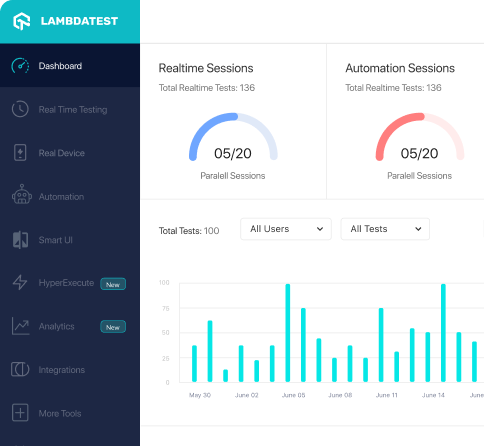How to use FieldMockDefect class of samples.junit4.system package
Best Powermock code snippet using samples.junit4.system.FieldMockDefect
Source:FieldMockDefect.java
...16 * Whitebox.setInternalState(mock, "name", Object.class.getName()); }17 */18@RunWith(PowerMockRunner.class)19@PrepareForTest(Field.class)20public class FieldMockDefect {21 @Test22 public void test() {23 final Field fieldMock = createMock(Field.class);24 expect(fieldMock.getName()).andReturn("foo");25 replayAll();26 Assert.assertEquals("foo", new FieldMockDefect.ClassUnderTest().foo(fieldMock));27 verifyAll();28 }29 private static final class ClassUnderTest {30 public String foo(Field field) {31 return field.getName();32 }33 }34}...FieldMockDefect
Using AI Code Generation
1import samples.junit4.system.FieldMockDefect;2import org.junit.Test;3import static org.junit.Assert.*;4public class FieldMockDefectTest {5 public void test() {6 FieldMockDefect mock = new FieldMockDefect();7 assertEquals(0, mock.getCounter());8 mock.increment();9 assertEquals(1, mock.getCounter());10 }11}12import samples.junit4.system.FieldMockDefect;13import org.junit.Test;14import static org.junit.Assert.*;15public class FieldMockDefectTest {16 public void test() {17 FieldMockDefect mock = new FieldMockDefect();18 assertEquals(0, mock.getCounter());19 mock.increment();20 assertEquals(1, mock.getCounter());21 }22}23import samples.junit4.system.FieldMockDefect;24import org.junit.Test;25import static org.junit.Assert.*;26public class FieldMockDefectTest {27 public void test() {28 FieldMockDefect mock = new FieldMockDefect();29 assertEquals(0, mock.getCounter());30 mock.increment();31 assertEquals(1, mock.getCounter());32 }33}34import samples.junit4.system.FieldMockDefect;35import org.junit.Test;36import static org.junit.Assert.*;37public class FieldMockDefectTest {38 public void test() {39 FieldMockDefect mock = new FieldMockDefect();40 assertEquals(0, mock.getCounter());41 mock.increment();42 assertEquals(1, mock.getCounter());43 }44}45import samples.junit4.system.FieldMockDefect;46import org.junit.Test;47import static org.junit.Assert.*;48public class FieldMockDefectTest {49 public void test() {50 FieldMockDefect mock = new FieldMockDefect();51 assertEquals(0, mock.getCounter());52 mock.increment();53 assertEquals(1, mock.getCounter());54 }55}56import samples.junit4.system.FieldMockDefect;57import org.junit.Test;58import static org.junit.Assert.*;59public class FieldMockDefectTest {FieldMockDefect
Using AI Code Generation
1import static org.junit.Assert.assertEquals;2import static org.junit.Assert.assertNotNull;3import static org.junit.Assert.assertNull;4import static org.junit.Assert.assertTrue;5import org.junit.Test;6import com.ibm.team.workitem.common.model.IAttribute;7import com.ibm.team.workitem.common.model.IWorkItem;8import com.ibm.team.workitem.common.model.Identifier;9import com.ibm.team.workitem.common.model.ItemProfile;10import com.ibm.team.workitem.common.model.ItemProfile.ITeamArea;11import com.ibm.team.workitem.common.model.ItemProfile.IType;12import com.ibm.team.workitem.common.model.ItemProfile.IWorkItemType;13import com.ibm.team.workitem.common.model.WorkItemOperation;14import com.ibm.team.workitem.common.model.WorkItemOperation.IAttributeOperation;15import com.ibm.team.workitem.common.model.WorkItemOperation.IAttributeOperation.IAddValue;16import com.ibm.team.workitem.common.model.WorkItemOperation.IAttributeOperation.IRemoveValue;17import com.ibm.team.workitem.common.model.WorkItemOperation.IAttributeOperation.IUpdateValue;18import com.ibm.team.workitem.common.model.WorkItemOperation.IAttributeOperation.IUpdateValue.IUpdateValueOperation;19import com.ibm.team.workitem.common.model.WorkItemOperation.IAttributeOperation.IUpdateValue.IUpdateValueOperation.IUpdateTextValueOperation;20import com.ibm.team.workitem.common.model.WorkItemOperation.IAttributeOperation.IUpdateValue.IUpdateValueOperation.IUpdateWorkItemValueOperation;21import com.ibm.team.workitem.common.model.WorkItemOperation.IAttributeOperation.IUpdateValue.IUpdateValueOperation.IUpdateWorkItemValueOperation.IUpdateWorkItemReferenceValueOperation;22import com.ibm.team.workitem.common.model.WorkItemOperation.IAttributeOperation.IUpdateValue.IUpdateValueOperation.IUpdateWorkItemValueOperation.IUpdateWorkItemReferenceValueOperation.IUpdateWorkItemReferenceAttributeOperation;23import com.ibm.team.workitem.common.model.WorkItemOperation.IAttributeOperation.IUpdateValue.IUpdateValueOperation.IUpdateWorkItemValueOperation.IUpdateWorkIteAutomation Testing Tutorials
Learn to execute automation testing from scratch with LambdaTest Learning Hub. Right from setting up the prerequisites to run your first automation test, to following best practices and diving deeper into advanced test scenarios. LambdaTest Learning Hubs compile a list of step-by-step guides to help you be proficient with different test automation frameworks i.e. Selenium, Cypress, TestNG etc.
LambdaTest Learning Hubs:
- JUnit Tutorial
- TestNG Tutorial
- Webdriver Tutorial
- WebDriverIO Tutorial
- Protractor Tutorial
- Selenium 4 Tutorial
- Jenkins Tutorial
- NUnit Tutorial
- Jest Tutorial
- Playwright Tutorial
- Cypress Tutorial
- PyTest Tutorial
YouTube
You could also refer to video tutorials over LambdaTest YouTube channel to get step by step demonstration from industry experts.
Most used methods in FieldMockDefect
Try LambdaTest Now !!
Get 100 minutes of automation test minutes FREE!!


